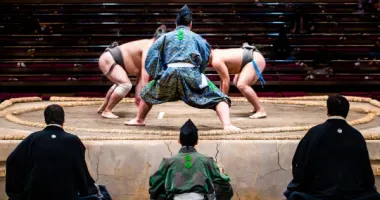Naritasan Shinshoji Temple - Main Temple Features
Naritasan Shinshoji Temple 成田山新勝寺
- History
- Omotesando
- Somon Gate
- Daihondo Main Hall
- Shakado Hall
- Shusse-Inari Shrine
- Komyodo Hall
- Great Peace Pagoda
- Narita-san Park
- Narita-san Calligraphy Museum
- Narita-san Events
- Narita-san Car Blessing Temple
- Access
- Japan Temples & Shrines
Daihondo Main Hall 大本堂

Daihondo Main Hall with Three Tiered Pagoda, Naritasan Temple, Narita
The imposing Great Main Hall (Daihondo) straight ahead houses Kukai's image of Fudomyo. The 25 m (82 ft) high Sanju-no-to three-tiered tower to the right was built in 1712 and is an Important Cultural Property of Japan. Check out its rich, gorgeous decorations. The elegant little round pagoda to the right of the tower is Shotoku Taishi Do, dedicated to the apotheosized Japanese leader, Prince Shotoku (572 - 622 AD), and to the cause of world peace.
Shakado Hall 釈迦堂
To the left of the Daihondo, on the other side of the spoked-wheel-like plaza, is the original main temple hall, the Shakado (Shakyamuni Hall), built in 1858. It used to occupy the site of the Daihondo until 1964 when it was moved to make way for the new and bigger Daihondo. The Shakado is a fine example of extant late-Edo era architecture.

Shakado Hall, Naritasan Temple
Shusse-inari Shrine 出世稲荷
Across the plaza in front of the Shakado (i.e., left out of the main Nioumon gate) is the Shinto shrine, Shusse-inari, situated on a small rise accessed up a long ramp. Gifted by worshippers in the Edo era, it is a place to pray for luck, especially in business. This being an Inari shrine, the fox is revered as the messenger of the god, Inari, that is enshrined here, so sellers at the entrance sell fried tofu, supposedly loved by foxes, to place inside as an offering.

Stairs to Shusse-Inari Shrine, Naritasan Temple

Torii gate at entrance to Shusse-inari Shrine, Naritasan Temple.
You can be forgiven for thinking that this area dominated by the Daihondo is the whole of Narita-san, but more lies beyond.
Komyodo Hall 光明堂
Progressing past the left-hand side of the Daihondo main hall, the path soon takes you past the open-air Gakudo Hall (more a shelter than a "hall") on your left, to the Komyodo (right in front of you). If the Shakado was the main hall before the Daihondo, then Komyodo, built in 1701, was the main hall before it, i.e. three main halls back. Komyodo is also an Important Cultural Asset of Japan. In May, it is the venue for takigi-noh, or "firelight noh" drama performances by night.

Komyodo Hall, Naritasan Temple
Great Peace Pagoda 平和の大塔
The crowning glory of Narita-san is the 58 m (190 ft) Great Peace Pagoda, on a rise overlooking Narita-san Park. This five-story pagoda was built in 1984 on the temple's 1,150th anniversary, and is modeled on the pagoda built by the founder of Shingon Buddhism, Kukai (posthumously known as Kobo-Daishi), on the sect's sacred Mt. Koya in Wakayama prefecture. The Great Peace Pagoda has a sutra-writing hall on the first floor, a Buddha hall on the second floor, a collection of sutras from all over Asia on the third floor, and an observation deck with a grand view of the temple complex on the fifth floor. In the underground floor is a world peace time capsule with messages from 11 world leaders, due to be opened in 2434.

Great Peace Pagoda, Naritasan Temple, Narita
Narita-san Park
Narita-san Park, a 16.5 ha (40 acre) expanse of landscaped greenery, occupies much of the Narita-san complex.
Keep reading about Narita-san Park.

Wood in Narita-san Park, Naritasan Temple
Narita Airport Hotels
Books on Japan
Read about the main temple features of Naritasan Shinshoji Temple in central Narita city in Chiba Prefecture.






























